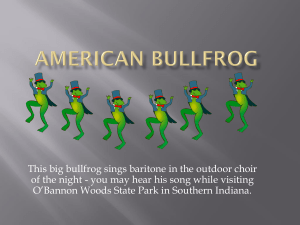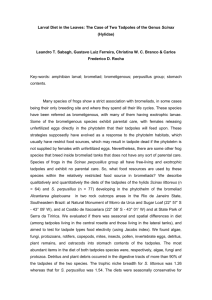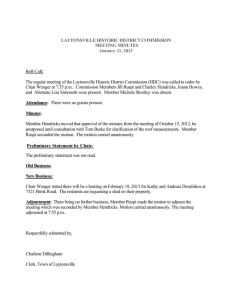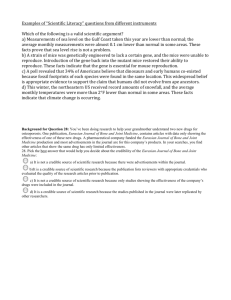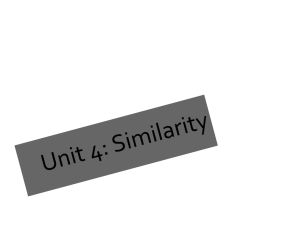Lithobates catesbeianus (American Bullfrog) Impacts Information
advertisement
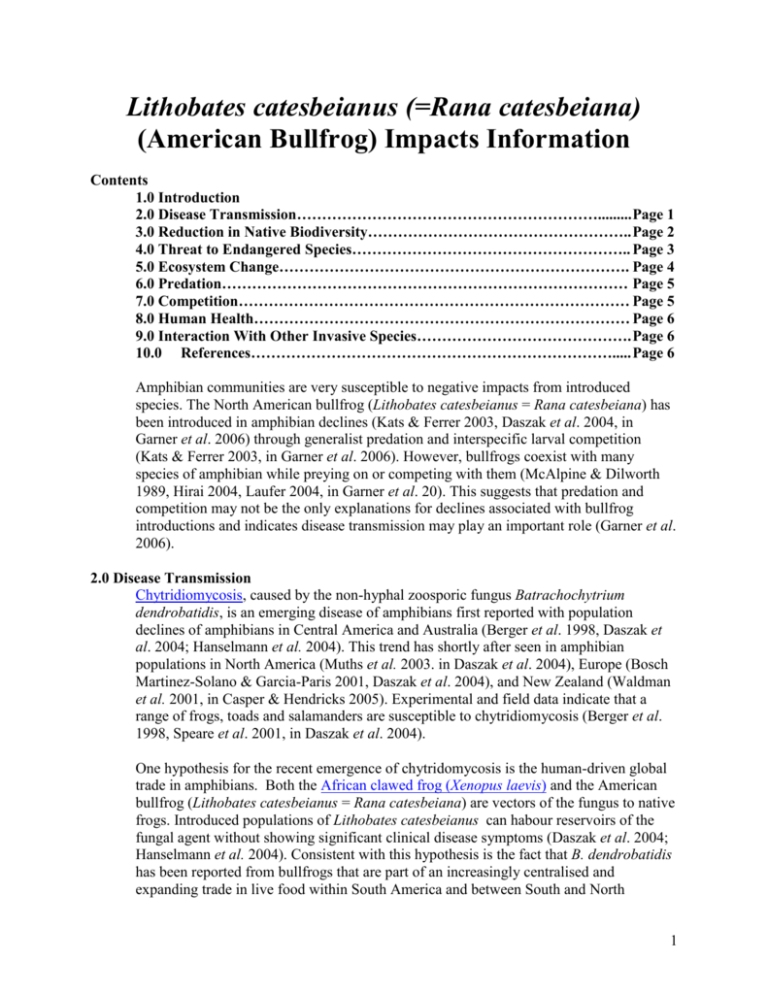
Lithobates catesbeianus (=Rana catesbeiana) (American Bullfrog) Impacts Information Contents 1.0 Introduction 2.0 Disease Transmission……………………………………………………......... Page 1 3.0 Reduction in Native Biodiversity…………………………………………….. Page 2 4.0 Threat to Endangered Species……………………………………………….. Page 3 5.0 Ecosystem Change……………………………………………………………. Page 4 6.0 Predation……………………………………………………………………… Page 5 7.0 Competition…………………………………………………………………… Page 5 8.0 Human Health………………………………………………………………… Page 6 9.0 Interaction With Other Invasive Species……………………………………. Page 6 10.0 References………………………………………………………………..... Page 6 Amphibian communities are very susceptible to negative impacts from introduced species. The North American bullfrog (Lithobates catesbeianus = Rana catesbeiana) has been introduced in amphibian declines (Kats & Ferrer 2003, Daszak et al. 2004, in Garner et al. 2006) through generalist predation and interspecific larval competition (Kats & Ferrer 2003, in Garner et al. 2006). However, bullfrogs coexist with many species of amphibian while preying on or competing with them (McAlpine & Dilworth 1989, Hirai 2004, Laufer 2004, in Garner et al. 20). This suggests that predation and competition may not be the only explanations for declines associated with bullfrog introductions and indicates disease transmission may play an important role (Garner et al. 2006). 2.0 Disease Transmission Chytridiomycosis, caused by the non-hyphal zoosporic fungus Batrachochytrium dendrobatidis, is an emerging disease of amphibians first reported with population declines of amphibians in Central America and Australia (Berger et al. 1998, Daszak et al. 2004; Hanselmann et al. 2004). This trend has shortly after seen in amphibian populations in North America (Muths et al. 2003. in Daszak et al. 2004), Europe (Bosch Martinez-Solano & Garcia-Paris 2001, Daszak et al. 2004), and New Zealand (Waldman et al. 2001, in Casper & Hendricks 2005). Experimental and field data indicate that a range of frogs, toads and salamanders are susceptible to chytridiomycosis (Berger et al. 1998, Speare et al. 2001, in Daszak et al. 2004). One hypothesis for the recent emergence of chytridomycosis is the human-driven global trade in amphibians. Both the African clawed frog (Xenopus laevis) and the American bullfrog (Lithobates catesbeianus = Rana catesbeiana) are vectors of the fungus to native frogs. Introduced populations of Lithobates catesbeianus can habour reservoirs of the fungal agent without showing significant clinical disease symptoms (Daszak et al. 2004; Hanselmann et al. 2004). Consistent with this hypothesis is the fact that B. dendrobatidis has been reported from bullfrogs that are part of an increasingly centralised and expanding trade in live food within South America and between South and North 1 America (Mazzoni et al. 2003, in Daszak et al. 2004). Also supporting the hypothesis is the fact that the first documented occurrence of Batrachochytrium in Great Britain is at a site having the only breeding population of L. catesbeianus in the country, as well as a feral population of X. laevis (Cunningham et al. 2005, Fisher & Garner 2007, in Kraus 2009). Experimental evidence that bullfrogs can be infected by B. dendrobatidis, but are relatively resistant to the disease chytridomycosis and show no pathological signs of the disease, which is lethal to many other amphibian species, is provided by Daszak and colleagues (2004). In addition, Garner and colleagues found the molecular signal of chytrid infection from introduced bullfrogs collected on three separate continents (T.W.J. Gamer <i>et al</i>. Unpub. Data, in Garner <i>et al</i>. 2005). Symptoms of the chytridiomycosis include (1) the presence of a substantial area of hyperplasia and hyperkeratosis (between five and 10 cell layers thick) of the ventral skin containing substantial numbers of the fungus; (2) clinical signs such as lack of appetite, loss of righting reflex, and increased epidermal sloughing; and (3) rapid progression to death (Daszak et al. 2007). For more information on chytridiomycosis and its control in amphibian populations please visit the Amphibian Diseases Homepage. For an insight into the life history of Batrachochytrium dendrobatidis please refer to Garner and colleagues (2006) Please note that a variety of other factors, including habitat modification, presence of alien fish, commercial exploitation, disturbance regimes, diseases and toxicants may also be involved in declines of native herpetofauna or interact synergistically to exacerbate bullfrog effects (Kraus 2009). Negative effects of bullfrogs may be increased by habitat modifications (Kiesecker et al. 2001, Rosen & Schwalbe 2002, in Cook & Jennings 2007). Although infection by Mycobacterium marinum, found in the bullfrog, is not frequently described, aquatic vertebrates such as frogs, snakes and turtles have been considered as a source of infection for fish (Decostere et al., 2004, in Ferreira et al. 2004; also see Human Health). A pathogens belonging to the Iridoviridae family, Ranavirus, was suspected to be causing mortality in Uruguayan and Brazilian bullfrog farms (Galli et al. 2006). Adult and larval Falcaustra catesbeianae nematodes were collected from the bullfrog in Japan (Hasegawa 2006). Bullfrogs also host many parasites including helminths, platyhelminths such as trematodes and nematodes, protozoans and mesozoans and leeches (Modzelewski & Culley 1974, Kennedy 1980, Barta & Desser 1984, Bury & Whelan 1984, Desser et al. 1986 1990, Desser 1987, Shields 1987, Chen & Desser 1989, Siddall & Desser 1992, Desser et al. 1995, Smith et al. 1996 2000, Crawshaw 1997, Bursey & DeWolf 1998, McAlpine & Burt 1998, in Casper & Hendricks 2005). 3.0 Reduction in Native biodiversity Beginning in the early 1970s, evidence began to accumulate indicating that bullfrogs are at least partly responsible for the decline of a diversity of native herpetofauna (reptiles and amphibians) across the western USA. Early surveys by Moyle (1973, in Doubledee 2 Muller and Nisbet 2003) found an abundance of bullfrogs in habitat formerly occupied by native frogs in California's southern central valley and suggested a causal relationship between bullfrog presence and the absence of native anurans. Other evidence includes anecdotal (Lardie 1963, Dumas 1966, Hammerson 1982, in Kraus 2009), statistical (Schwalbe & Rosen 1988, Fisher & Shaffer 1996, Kupferberg 1997a, Rosen & Schwalbe 2002, in Kraus 2009) and experimental (Kieseker & Blaustein 1997 1998, Kupferberg 1997a, Lawler et al. 1999, Adams 2000, Pearl et al. 2004, Maret et al. 2006, in Kraus 2009). Because of their restricted habitat requirements, pond-breeding amphibians are particularly affected by exotic species and habitat modifications (Cook & Jennings 2007). It should be noted that habitat destruction and predation pressure from other introduced predators, such as fish, red-swamp crayfish (Procambarus clarkii), and signal crayfish (Pacifasticus leniusculus) have hampered the ability of scientists to directly assess the threat of introduced bullfrogs on native amphibians (US Fish and Wildlife Service 2002, in Doubledee Muller & Nisbet 2003). The impacts of these other predators are a large decrease in survivorship of eggs and larvae, and possibly a decrease in juvenile and adult survivorship of native frogs (Kiesecker and Blaustein 1998, Lawler et al. 1999, in Doubledee Muller & Nisbet 2003). Hayes and Jennings (1986, in Casper & Hendricks 2005) argued that while bullfrogs are often invoked as being responsible for declines in native ranid frogs, existing data cannot distinguish adequately among three major causal hypotheses for this decline: bullfrogs, habitat alteration, and introduced predatory fish. They believed that fish predation was the most compelling hypothesis in relation to the USA (Casper & Hendricks 2005) In the USA the bullfrog has been implicated in the decline of (Casper & Hendricks 2005; Kraus 2009): the entire suite of central Californian amphibians (Fisher and Shaffer 1996, in Kraus 2009); and native amphibians in Iowa (Lannoo et al. 1994, in Casper & Hendricks 2005). the Pacific chorus frog (Pseudacris regilla); (Jameson, 1956, in Kraus 2009); the plains leopard frog (Lithobates blairi); (Colorado; Hammerson 1982a 1982b, in Casper & Hendricks 2005); the northern leopard frog (Lithobates pipiens); (Hammerson 1982, in Kraus 2009); o Hecnar & M’Closkey (1996, in Hirai 2004) observed the increase of the northern leopard frog and green frogs (Rana clamitans) after the extinction of the introduced bullfrog in Canada. the lowland leopard frog (Lithobates yavapaiensis); (Schwalbe & Rosen 1988, Rosen & Schwalbe 1995 2002, in Kraus 2009); and Blanchard's cricket frog (Acris crepitans); (Ontario, Oldham 1992; in Casper & Hendricks 2005), the Pacific treefrog (Pseudacris regilla); (Oregon; Jameson 1956b, in Casper & Hendricks 2005; California; Kupferberg 1997, in Casper & Hendricks 2005); o Kupferberg (1997) also found a 16% reduction in the size of newly metamorphosed Pacific treefrogs (Hyla regilla</i>), but no significant effect on survivorship; 3 the northern red-legged frog (Rana aurora); (Oregon; Kiesecker & Blaustein 1997, Kiesecker et al. 2001, in Cook and Jennings 2007); o Large overwintering bullfrog tadpoles had significant competitive impacts on young R. aurora tadpoles. They decreased survival and delayed time to metamorphosis of R. aurora, presumably by reducing food resources (Lawler et al. 1999, in Boone 2004); o However, in aquatic habitats which dry up seasonally and where overwintering of bullfrog tadpoles is prevented, competitive effects may not be significant. In addition to amphibians, the bullfrog may also threaten the Mexican garter snake (Thamnophis eques). Schwalbe and Rosen (1988 1999, in Casper & Hendricks 2005) found evidence that bullfrogs are responsible for declines in Mexican garter snakes from the San Bernardino National Wildlife Refuge (Arizona, USA). Similar declines in native species concurrent with the introduction of bullfrogs have been noted in Europe, in Germany (C.R. Boettger 1941, Thiesmeier et al. 1994, in Kraus 2009), Florence (Italy) (native Rana</i>; Touratier 1992b, in Kraus 2009) and in the Aquitaine of southwestern France (native fish; Touratier 1992a, in Kraus 2009). Concern has been expressed about their potential effects elsewhere in Europe (Albertini & Lanza 1987, Stumpel 1992, in Kraus 2009). In Japan Hirai (2006b) identified, via stomach analysis, the following prey items taken by bullfrogs: the long-jawed water spider (Tetragnatha maxillosa); the paddy field grasshopper (Oxya velox); the giant water bug (Appasus japonicus); and the Japanese Fire-bellied Newt (Cynops pyrrhogaster) o It is said that in the skin of Cynops pyrrhogaster there is a tetrodotoxin which the bullfrog may be immune to. 4.0 Threat to Endangered Species Introduced exotic predators, including the bullfrog, threaten the following amphibian species: the possibly Extinct (according to the IUCN Red List) Vegas Valley leopard frog (Lithobates fisheri); (Nevada; Moyle 1973, Cohen 1975, in Casper & Hendricks 2005); the Federally Endangered Sonoran tiger salamander Ambystoma tigrinum stebbinsi (subspecies of the tiger salamander (Ambystoma tigrinum)); (Maret et al. 2006, in Kraus 2009); o This genetically distinct race is restricted to about 30 small ponds in the San Rafael Valley 111 southern Arizona, USA; the IUCN Red List Endangered Amargosa Toad (Anaxyrus nelsoni); (Nevada; Jones et al. 2003, in Kraus 2009); (restricted range) the Federally Endangered and IUCN Vulnerable California tiger salamander (Ambystoma californiense); (California; Balfour and Stitt 2003, in Kraus 2009); 4 the IUCN Vulnerable Chiricahua leopard frog (Lithobates chiricahuensis); (Arizona Schwalbe & Rosen 1988, in Casper & Hendricks 2005); the Federally Threatened and IUCN Vulnerable California red-legged frog (Rana draytonii); (Miller et al. 1996, in Cook & Jennings 2007); o An approximately 70% decline in the range of this frog, primarily due to habitat loss and the introduction of exotic species, including the bullfrog has resulted in the listing of this species as threatened under the federal Endangered Species Act; the IUCN Vulnerable Oregon spotted frog (Rana pretiosa); (Montana; Dumas 1966, Black 1969a, in Cook & Jennings 2007); the IUCN Near Threatened boreal toad (Anaxyrus boreas); and the IUCN Near Threatened foothill yellow-legged frog (Rana boylii); (California. Kupferberg 1997, in Casper & Hendricks 2005); o Presence of bullfrogs was correlated with decreased growth rates and survival of tadpoles of the foothill yellow-legged frog (Rana boylii), probably due to bullfrogs being better adapted at exploiting algal resources (Laufer & Sandte 2004, Kupferberg 1997a, in Kraus 2009); o The presence of bullfrog tadpoles resulted in a 48% reduction of survivorship of foothill yellow-legged frog (Rana boylii</i>) tadpoles, and a 24% decline in mass at metamorphosis (Kupferberg 1997). In addition to amphibians in the USA the bullfrog may also threaten these native fauna: the endangered Gallinula chloropus sandvicensis in Hawaii, subspecies of the common moorhen (Gallinula chloropus); (Viernes 1995, in Kraus 2009). the endangered Poeciliopsis occidentalis sonoriensis, subspecies of the charalito (fish) (Poeciliopsis occidentalis) (Schwalbe & Rosen 1988); the endangered yaqui chub (fish) (Gila purpurea) (Schwalbe & Rosen 1988, in Kraus 2009); the IUCN Red List Vulnerable Pacific pond turtle (Actinemys marmorata); Hays et al. 1999, in Kraus 2009); the IUCN Red List Endangered Razorback Sucker (Xyrauchen texanus); o Tadpoles of L. catesbeianus prey on the eggs and larvae of the razorback sucker in laboratory conditions and their densities in artificial habitats can decrease fish larvae recruitment (Mueller et al. 2006, in Kraus 2009); the IUCN Vulnerable giant garter snake (Thamnophis gigas) in California (Wylie et al., 2003, in Kraus 2009); and the regionally rare white-cheeked pintail (Anas bahamensis) in Puerto Rico (López-Flores et al. 2003, in Kraus 2009). In Japan the bullfrog also preys upon: the IUCN Near Threatened black-spotted pond frog (Pelophylax nigromaculatus); and an endangered (according to Ota et al. 2004a, in Kraus 2009) freshwater crab (Candidiopotamon kumejimense) on Kumejima Island. 5 5.0 Ecosystem change Several field studies portray tadpoles as ‘‘ecosystem engineers’’ that alter the biomass, structure and composition of algal communities (Dickman 1968, Seale 1980, Osborne & McLachlan 1985, Kupferberg 1997a, Flecker et al. 1999, Peterson & Boulton 1999, in Pryor 2003). Tadpoles play an influential role in transferring nutrients between ecosystems (Pryor 2003). Upon metamorphosis, anuran larvae transfer nutrients from aquatic to terrestrial ecosystems. High food intake (Wassersug 1984, in Pryor 2003) and high population densities (up to thousands of individuals per m²; Alford, 1986, in Pryor 2003) suggest that tadpoles have considerable impact on nutrient cycling and primary production in freshwater ecosystems. 6.0 Predation American bullfrogs are voracious predators and are considered detrimental to native amphibians and other fauna (Moyle 1973, Bury & Luckenbach 1976, Rosen & Schwalbe 1995, in Adams Pearl & Bury 2003). Experiments have confirmed bullfrogs mediate their negative effects in part via direct predation (Kiesecker & Blaustein 1997; also see relevant information provided in Reduction in Native Species and Threat to Endangered Species). As the bullfrog is known to feed frequently on aquatic prey such as crayfish, dragonfly nymphs, aquatic hemipterans and water beetles (Tyler & Hoestenbach 1979, Werner et al. 1995, in Hirai 2004), and therefore benthos and aquatic insect communities can receive a certain impact from the bullfrog’s predation. 7.0 Competition Bullfrogs compete with native species (Kupferberg 1997, Kiesecker & Blaustein 1997, in Hanselmann et al. 2004) and unlike many other frogs can coexist with predatory fish (Hecnar 1997, in Casper & Hendricks 2005). Overwintered bullfrog tadpoles can affect development and survival of other anuran species (e.g., Kupferberg 1997, Lawler et al. 1999, Kiesecker et al. 2001, in Boone 2004) and can be competitively superior to anurans with larval periods of less than one year (Werner & Anholt 1996, in Boone 2004). The presence of overwintered bullfrog tadpoles reduced the mass at metamorphosis of the southern leopard frog (Rana sphenocephala) and shortened the larval period and reduced mass at metamorphosis for the spotted salamander (Ambystoma maculatum) (Boone 2004). In experimental environments, Werner and Anholt (1996, in Cook & Jennings 2007) and Kiesecker and colleagues (2001, in Cook & Jennings 2007) demonstrated competition between bullfrog tadpoles and green frog (Rana clamatans) tadpoles at densities of 22 tadpoles/m² and between bullfrog tadpoles and red-legged frogs at 9 tadpoles/m², respectively. However competitive densities as obtained in experimental studies above may not occur at field sites (Cook & Jennings 2007). For amphibian species that have evolved with bullfrogs, the presence of bullfrogs may be less serious. The effects of overwintered bullfrog tadpoles in the study by Boone (2004) were neutral or negative, affecting time to metamorphosis and/or weight at metamorphosis. Studies with bullfrogs outside their range have shown similar results and additionally found that bullfrog tadpoles have negative effects on survival. Kiesecker and Blaustein (1997, in Boone 2004) found tadpoles of red-legged frogs (Rana aurora) 6 syntopic with Bullfrogs increased their survival by altering their behavior in the presence of bullfrogs. Populations of red-legged frogs allopatric (ie. evolutionarily naive) to bullfrogs, however, suffered increased mortality because tadpoles did not alter their behavior in the presence of bullfrogs. 8.0 Human Health The occurrence of mycobacteriosis caused by Mycobacterium marinum in a commercial breeding farm of bullfrogs (Lithobates catesbeianus ) in Rio de Janeiro, Brazil is described by Ferreira and colleagues 2004. Human cases of M. marinum infection have been reported from different parts of the world (Ghittino & Bozzetta 1994, Lewis et al. 2003, in Ferreira et al. 2004). It is characterised by skin lesions commonly called ‘‘swimming pool granuloma ’’ or ‘‘fish tank granuloma’’ (Ferreira et al. 2004). 9.0 Interaction With Other Invasive Species Positive interactions among non-native species could greatly exacerbate the problem of invasions (Adams Pearl & Bury 2003). Bullfrog invasion in Oregon, USA, is facilitated by the presence of non-native fish, which increase tadpole survival by reducing predatory macroinvertebrate densities. Native dragonfly nymphs in caused no survival of bullfrog tadpoles in a field experiment unless a non-native sunfish was present to reduce dragonfly density. This evidence supports the “invasional meltdown” hypothesis (see Simberloff & Von Holle 1999) (Adams Pearl & Bury 2003). 10.0 References For references please see the GISD Species Profile for Lithobates catesbeianus (References Section). 7
